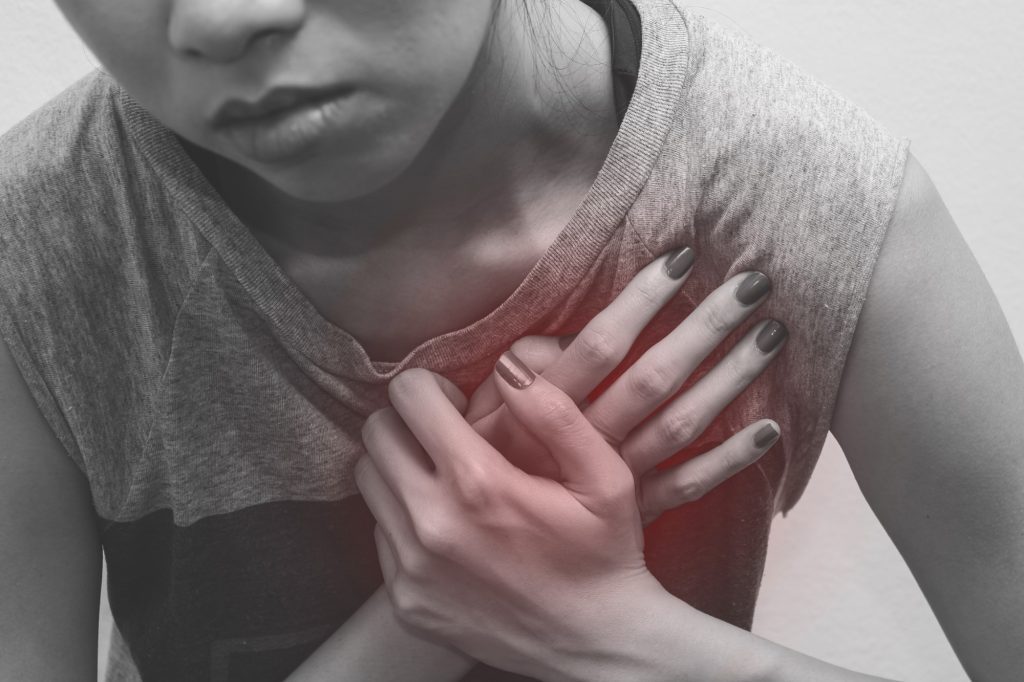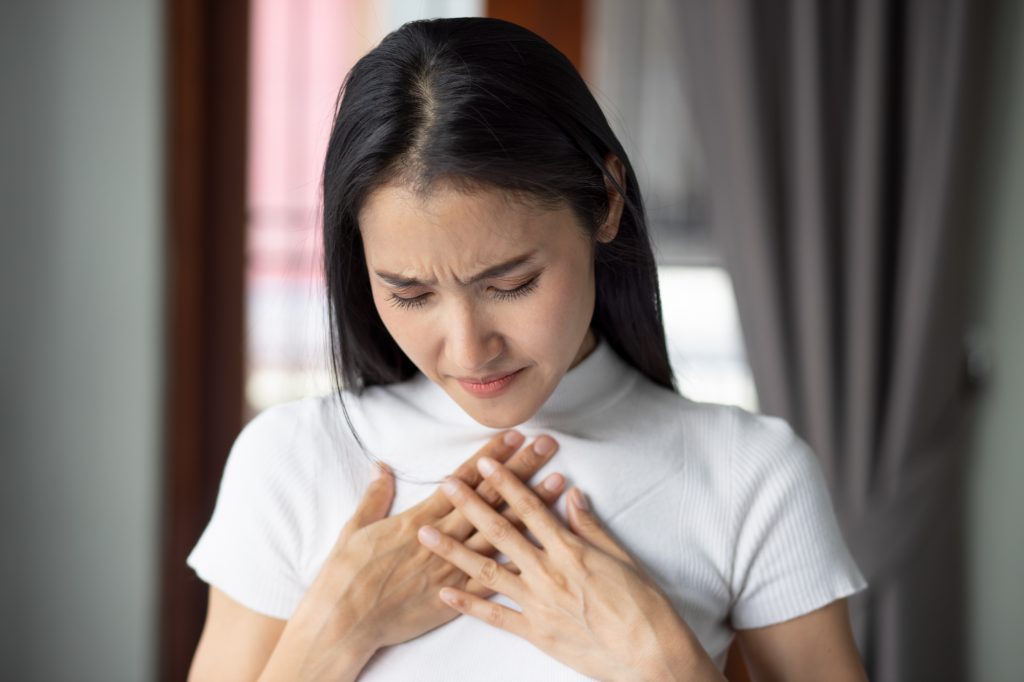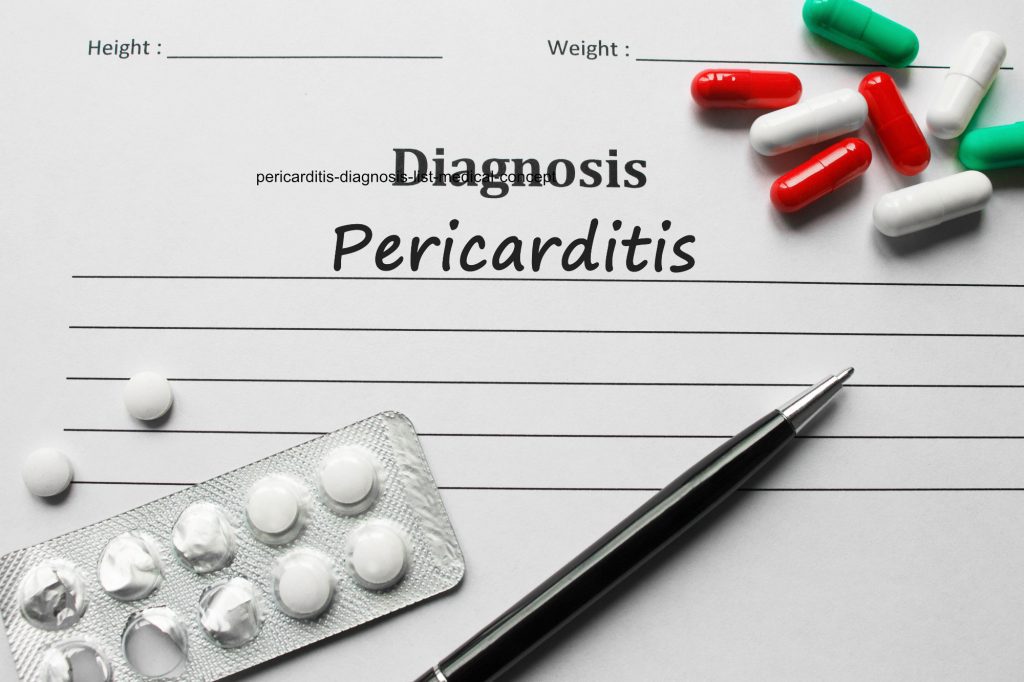Introduction
Sharp chest pain is one of the primary causes of why people make emergency room visits. It may feel like a sudden sharp pain in your chest that makes you think you are about to have a heart attack or a lung problem. Because chest pain is not something to ignore, this article will help address what causes chest pain that goes away almost as quickly as it comes and how can chest pains be cured.

Common causes of sharp chest pain
Numerous diseases, such as muscle injuries or problems with your lungs, stomach, or heart, can cause sharp chest pain. So, it is difficult to describe the possible causes of sharp chest pain in this article, but here are some more common causes.
Precordial Catch Syndrome
Precordial catch syndrome (PCS) is a heart-related condition mainly affecting children and teenagers. This condition creates a brief burst of sharp pain on the left side of the chest.
The pain is so sharp even normal breathing could worsen it. PCS is frequently experienced during periods of relaxation or while a person changes postures.
However, the discomfort only lasts for a short period, usually up to 3 minutes, and leaves no aftereffects once it’s gone.
PCS has no known or proven cause. According to doctors, the intercostal muscles, located between the ribs, maybe spasming. These spasms could irritate neighboring nerves and lead to pain.

Symptoms
Sharp pain in the left side of your chest, close to your heart, is the most prominent sign of precordial catch syndrome. You might realize that the sharp chest pain only affects a single spot and won’t spread to other areas of your body, unlike heart attacks.
The discomfort in your chest might feel worse if you move or take a deep breath. Therefore, you can strive to maintain your stillness and breathe through your mouth. If you don’t take a deep breath for a while, you can start feeling lightheaded. However, that might not be a clear sign of precordial catch syndrome. Most times, your breathing pattern is the cause of it.
The discomfort associated with precordial catch syndrome often disappears between 30 seconds and 3 minutes. It may take up to 30 minutes for some people. Whichever is the case, you’ll feel better as soon as the discomfort subsides.
Causes
The cause of Precordial Catch Syndrome is unknown to medical professionals. It can be a symptom of a pinched nerve or a muscle spasm in the chest wall or lining of the chest. It has no connection to any diseases in your heart or lungs and does not affect them.
It might occur during a growth spurt in certain people. Others may experience it while they are under stress or anxiety.
Precordial catch syndrome can likely occur when you sit still and assume a bad posture. Most sufferers are inactive people who slump in front of the TV or sit in a spot for too long. It typically does not happen while you are eating or sleeping.
Diagnosis
A visit to the hospital will have the doctor physically examine you, ask questions about your symptoms, and review your medical history.
If they are certain you don’t have any more symptoms or risk factors for another illness, they may decide you don’t need any testing. If your doctor thinks there might be another problem, they might ask for an ultrasound or X-ray.
Treatment
Precordial catch syndrome pain dissipates quickly. The person with the syndrome should require no pain medication or other treatment.
Even though it might hurt to take that deep breath, some people discover that when they experience an intense stabbing pain in their chests, doing so may cause the discomfort to subside. You might feel better if you stretch or adjust your posture.
Outlook
Children between the ages of 6 and 12 have the highest incidence of precordial catch syndrome. Both sexes are equally impacted. It occurs far less often in adulthood.
Heart attack
A heart attack is a severe reduction in blood flow to the heart muscle or a total blockage of that blood flow.

A chest discomfort, dull, excruciating, or stabbing pain could indicate a heart attack. The pain may be felt in the chest’s center or just to the left of it. Other parts of the body may also be affected, including:
- Between one’s shoulder blades
- The head
- The jaw
- The left arm
Other heart attack signs and symptoms include:
- Pressure or stiffness in the chest
- sweating
- unexpected nausea or vomiting
- emotions of dread
Pain from a heart attack typically begins gradually over a few minutes and lasts for more than a few minutes. It might also subside for a while and return with more intensity.
Heart attacks are Medical emergencies, and emergency services should be contacted immediately by anyone who believes they have a heart attack or that someone else is.
People with heart disease should seek medical care even if there have been no prior symptoms. It’s clinically proven that a person may have their first heart attack as the first symptom of heart disease, according to the Centers for Disease Control and Prevention (CDC).
Treatment
The cause and severity of a heart attack will determine the course of treatment. Although some patients may not need surgery to expand the coronary artery or redirect blood flow away from a blocked or narrowed portion, medications can sometimes lessen and prevent blood clot formation.
Heartburn
Heartburn results from stomach acid spilling from the stomach and rising to the esophagus (the tube that links the mouth to the stomach), leading to chest pain.

Heartburn often manifests as a scorching or piercing ache in the middle of the chest. The neck might feel the pain as well.
Additional symptoms may also accompany heartburn, including:
- Stomach upset
- partially regurgitating food
- sensations of fullness or bloating
- excess gas
- and burping
- as well as a sour taste in the mouth, especially after burping.
Treatment
Occasional heartburns are sometimes normal and shouldn’t cause you to panic.
However, persistent heartburn might be a gastroesophageal reflux disease (GERD) symptom. Stomach acid regularly escapes into the esophagus in persons with GERD, resulting in recurrent pain, discomfort, or irritation episodes.
Some people may need to take over-the-counter (OTC) or prescription drugs to treat heartburn. Several instances include:
- Blockers of H2 (also called H2 antagonists)
- Antacids
- Drugs that speed up stomach emptying
- Proton pump inhibitors
Angina
Angina is a severe heart-related condition where the restricted blood supply to the heart causes chest pain. It is not an illness in and of itself but rather a sign of a heart condition.
Chest pain, pressure, or squeezing are typical symptoms of angina. The following body regions may also feel these sensations:
- the head
- it’s jaw
- the back
- the arms or shoulders
When you rest for a few minutes, the chest pain usually disappears. Chest pain frequently arises in response to physical exertion or stress. Additional indications of angina include:
- fatigue
- breathlessness
- lower chest or abdominal pain
- nausea
The signs of angina can resemble those of a heart attack. Anyone experiencing an angina attack or knows anyone who is should consult a physician. The physician will decide whether immediate medical attention is required.
Muscle, Nerve, or Bone Issues
Chest pain can occasionally result from overuse or a chest injury caused by a fall or accident. Viruses are also a contributing factor to what causes chest pain.
Additional reasons for chest discomfort include:
- Rib issues.
Breathing deeply or coughing may worsen rib pain. It frequently affects one location, and pressing on it could be painful. There could also be an inflammation in the region where the ribs connect to the breastbone.
- Muscle ache
Chest pain can result from vigorous coughing that damages or inflames the tendons and muscles between the ribs. The pain usually lingers and gets worse with activities.
- Shingles.
Shingles, a condition brought on by the varicella-zoster virus, can start as sharp, band-like pain and progress to a recognizable rash a few days later.
If you have any of these symptoms or know someone who does, you should relay the information to a physician because proper treatment by a specialist is how chest pain can be cured effectively.
Pericarditis
Pericarditis is a heart-related condition where the pericardium, a delicate tissue membrane surrounding the heart, becomes inflamed.
A person with pericarditis will have a sudden, acute discomfort in the middle or left side of their chest, which will usually get worse when they breathe deeply. A person’s pain may also intensify while lying down, although it frequently subsides as they stand up or lean forward.

Other pericarditis signs and symptoms include:
- chest tightness
- heart flutters
- having trouble breathing
- weakness
- swelling in the legs or abdomen and a slight fever
- overall weariness
Treatment
A doctor might advise taking over-the-counter anti-inflammatory drugs like aspirin or ibuprofen.
A doctor may also recommend a course of antibiotics if the disease has a bacterial etiology.
Panic Attack
The sensation of extreme terror is called a panic attack. A stressful situation may trigger it, or it may appear suddenly.

The following symptoms—at least four of them—are clinically proven indications of a panic attack, according to the Anxiety and Depression Association of America:
- Discomfort or chest pain
- increased heart rate or palpitations
- Sensation like one is about to suffocate or choke.
- breathing difficultly
- unusually hot or chilly feelings
- sweating
- quaking, trembling
- numbness or tingling in the extremities
- a sense of faintness or wooziness
- feeling queasy
- nausea
- dreadful thoughts
- dread of losing control
- the fear of dying
According to the National Institute of Mental Health, the symptoms start rapidly and peak in just a few minutes.
Fractures or strains
A cracked rib bone or a strained chest muscle could cause a sharp stabbing sensation in the chest. Sudden, acute pain at the site of the harm could result from either kind of injury.
Chest injuries may result from various factors, such as wrongly lifting weights or other large objects and a chest exercise that is too challenging.
Treatment
A strained chest muscle can be treated like any other type of muscular strain. It includes elevating, compressing, relaxing, and applying ice to the injured area. The RICE method is the name given to this method.
Usually, a broken rib will mend completely on its own in 3–6 weeks. An individual can also take OTC painkillers to get relief in the meantime.
Pleuritis
The lining of the chest and lungs can become inflamed and irritated, causing what is known as pleuritis. While performing certain body actions, the condition might result in brief, severe chest pain, including:
- breathing
- coughing
- sneezing
As a result of the following, pleuritis may develop:
- Bacterial or viral infections
- Acute rheumatic fever
- obstruction of a pulmonary artery
- an unsteady lung
- growths in the lung’s interpleural space
Treatment
Depending on the underlying reason, different pleuritis treatments are available.
Some possible treatments include:
- Using antibiotics to treat bacterial causes
- Surgery to repair a collapsed lung or remove growths from the pleural cavity
- drugs to stop blood clots from growing larger and preventing new clots from developing
Prevention
Some reasons for chest pain might not always be preventable. People can, however, take precautions to lower their chance of experiencing chest pain as a result of heart disease.
The CDC offers the following recommendations for lowering the risk of heart disease:
- stopping smoking, if necessary
- exercising regularly
- eating a balanced, variety-filled diet
- achieving or preserving a healthy weight
- lowering cholesterol and blood pressure
- treating any underlying medical problems
When to see a Physician
Regardless of additional symptoms, a person should visit a doctor for recurrent chest pain. Sharp chest pain frequently could indicate an underlying medical condition, including a heart or lung condition.
If someone experiences any heart attack symptoms or has an episode of angina that lasts for five minutes or more after receiving a second dose of angina medication, they should call emergency services.
Wrapping Up
Young or old, most people experience sharp, stabbing chest discomfort, typically brought on by less serious diseases like some of the conditions mentioned in the article. But occasionally, it might be an indication of a more serious problem that requires urgent medical care.
Even though the article did address important questions, such as how can chest pains be cured, still see a doctor as soon as you can if you experience chest discomfort that is fresh, persistent, or feels very serious. Especially if you have a history of heart or lung disease, what causes sharp chest pain can be a variety of symptoms, so early intervention can lower the likelihood of escalating the problem and may even save a person’s life.


